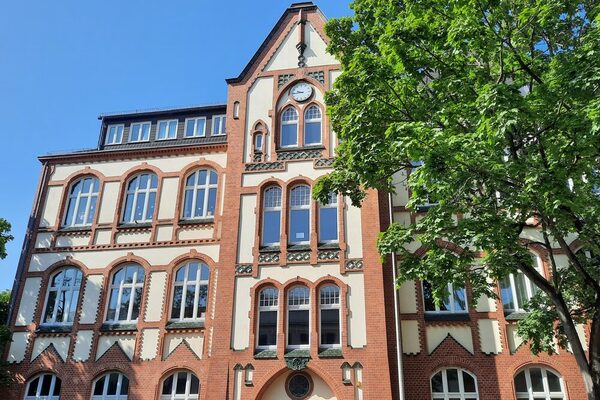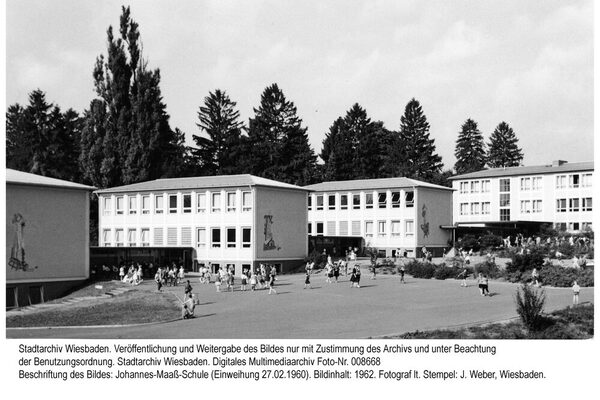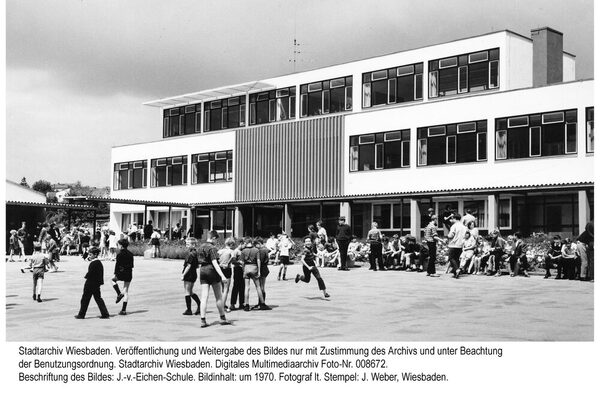Elementary school
On 01.12.1966, with the changeover of the start of the school year from spring to 01.08, the former primary schools were divided into primary and lower secondary schools. In the 2015 school year, there were 37 public elementary school in Wiesbaden, two of which had branches, and six private elementary school. Many of them have childcare facilities, some with lunchtime meals, pre-primary classes and entry levels and special services for migrants, which are not discussed individually below. Like the other schools in Wiesbaden, the elementary school, which in many cases can be traced back to the old elementary and later elementary school, have a long and varied history, which is associated with numerous relocations, renaming and mergers.
One of the oldest is the Anton Gruner School in Lehrstraße, which was built in 1842 after the old Sauerland School was abandoned and partly rebuilt in Art Nouveau style by Felix Genzmer around 1900. Genzmer was also the builder of the boys' elementary school on Blücherplatz, which was opened in 1897 and merged with the Ludwig Uhland School (previously the girls' elementary school on Blücherplatz) in 1975. Diesterwegschule on Waldstraße was opened in 1902 as Oranierschule and renamed in 1922. The school on Lorcher Straße from 1909 was an all-girls school for a long time before offering co-educational classes from 1963 as Friedrich-von-Schiller-Schule; since 2010, the elementary school in Künstlerviertel and since 2016 the elementary school in Hollerbornstraße have been part of it as a branch. Fritz-Gansberg-Grundschule goes back to a school founded in 1906 on Mainzer Landstraße and moved to Bierstadter Straße in 1929. The predecessor of the Hebbelschule was the Gutenbergschule built by Felix Genzmer in 1905. In 1926, it moved to Hebbelstraße, after which it was named from then on. The Riederbergschule is the successor to the school on Kastellstraße, which was opened in 1884 and whose boys' branch was separated in 1951 and moved into the former secondary school building on Riederbergstraße.
After the Second World War, numerous new schools were built, such as the Adalbert-Stifter-Schule in the city center, which was opened in 1949 as a school on Siegfriedstraße and renamed in 1956; it was a primary and secondary school and is now only an elementary school. The Brückenschule is now housed in the former secondary school wing. The Robert Schumann School (1950) and the Friedrich Ludwig Jahn School (1953) date from the 1950s. In the following decade, the Johannes-Maaß-Schule (1960) and the Joseph-von-Eichendorff and Geschwister-Scholl-Schule (1966) were founded on Freudenberg and in Klarenthal. The Schelmengraben elementary school was opened in 1973 when the new housing estate was occupied. The Alfred Delp School, built in 1962, was attached to it as a branch. Dotzheim is home to the Sauerland elementary school, which opened in 1998.
Some of the elementary school in the suburbs show greater continuity than those in the city center, such as the elementary school in Bierstadt, which emerged from a merger of the Hermann-Löns and Robert-Koch schools, which were founded in 1907 and go back to the so-called old school of 1946, which was rebuilt in 1896-99. The Brüder Grimm School in Kostheim was initially built around 1925 in two pavilions on Schiersteiner Straße, and the new main building was inaugurated in 1953. It was given its name on this occasion. The Carlo-Mierendorff-Schule, formerly Knaben-Volksschule Kostheim (1963), is more recent; in 1966 the local girls' elementary school was incorporated into it. The Ernst-Göbel-Schule in Kloppenheim, which is also attended by the children from Heßloch, has its roots in the Reformation period. A new school was built in 1898 and the school was renamed in 1963.
Biebrich also has a long school tradition. The Freiherr-vom-Stein-Schule was founded in 1883 and a new building was constructed on Ludwig-Beck-Straße in 1958. The Goethe School, inaugurated in 1915 as the Hohenzollern School, was given its current name in 1919/20. The Ludwig-Beck-Schule dates from 1964 and the Otto-Stückrath-Schule from 1972. The Pestalozzi School, inaugurated in 1897 as an elementary school in the northern part of the district, has had its name since 1901. The Adolf Reichwein School with its branch Konrad-Duden School in Sonnenberg goes back to the old Rambach school building from 1823. The elementary school in Breckenheim has predecessors dating back to the 17th century, with the current building dating back to 1936. The Nordenstadt elementary school from 1824/25 was replaced by a new building in 1961; the current building dates from 1981. The Gustav Stresemann School in Kastel, founded in 1905, was given a new building in 1911. In 1963, the Wilhelm Leuschner School was separated from it. The Hafenschule in Schierstein looks back on a considerable age: it was founded around 1510, the first school building was erected in 1709, and new buildings were built in 1884, 1901-10 and 1956, from which the Kerschensteiner School emerged, among others. In 1970, the Erich Kästner School was separated from the now so-called Hafenschule.
The first school was built in Erbenheim in 1835 and the existing Justus von Liebig School in 1900. The Erbenheim Karl Gärtner School was built until 1969. The Kohlheck School in Dotzheim was opened in 1959. The Philipp-Reis-Schule, which emerged from the elementary school on Mühlgasse and Landgraben, dates back to the oldest school in Dotzheim from the late 17th century. The Peter Rosegger School in Igstadt was built in 1951, but originally dates back to the early 19th century. The Rudolf Dietz School in Naurod was opened in 1958.
Unless otherwise stated, the schools were named according to a magistrate's decision in September 1963.
Literature
School development plan of the state capital Wiesbaden 2010-2015.


